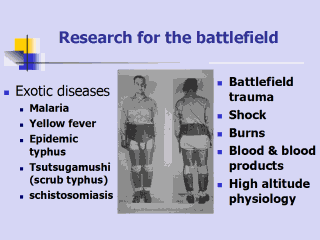 |
Research for the
battlefield included a wide variety of studies. Work on exotic diseases,
such as malaria, yellow fever, epidemic typhus, scrub typhus, and
schistosomiasis, refocused NIH scientists on the agency’s roots in
infectious diseases. Battlefield trauma, shock, and burns were some of the
other problems addressed. In consultation with the U.S. Navy, NIH scientists
determined the altitude at which oxygen had to be administered to prevent
pilots from blacking out. They developed a design for efficient functioning
of an apparatus to supply extra oxygen. The relation of pressure changes to
bubble formation in liquids was studied with reference to problems of emboli
forming in the blood of pilots. Other tests were made to evaluate the
efficiency of flight clothing, especially electrically heated suits. |
